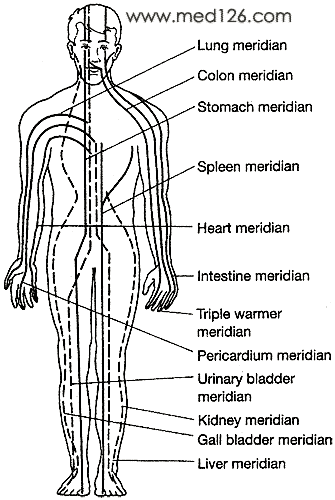
In traditional Chinese medicine theory, the meridians - or channels carry and distribute qi and blood to all parts of the body, connect the organs, limbs and joints.
When this flow of vital energy is disrupted, disease and poor health follow. Acupuncture evolved as a way of keeping channels open and energy flowing.
 .
.Primary meridians are those that pass through internal organs, while the secondary meridians do not. There are twelve pairs of primary meridians flowing in a never-ending circle. These twelve primary meridians are symmetrical on the right and left sides of the body, and they all interconnected with each other:
Our qi begins its flow in the lungs, then travels to the large intestine. From there it goes to the stomach, then to the spleen. Next it travels to the heart, then to the small intestine. Next it goes to the urinary bladder and the kidneys. After this it heads toward the pericardium and the sanjiau (also known as the triple burner). Finally it goes to the gall bladder, then the liver, then back to the lungs where it starts its circular journey again.
For a healthy person, the qi travels smoothly through each of the organs at a specific time of the day:
| Lungs | 3 A.M. - 5 A.M. |
| Large Intestine | 5 A.M. - 7 A.M. |
| Stomach | 7 A.M. - 9 A.M. |
| Spleen | 9 A.M. - 11 A.M. |
| Heart | 11 A.M. - l P.M. |
| Small Intestine | 1 P.M. - 3 P.M. |
| Urinary Bladder | 3 P.M. - 5 P.M. |
| Kidneys | 5 P.M. - 7 P.M. |
| Pericardium | 7 P.M. - 9 P.M. |
| Triple Burner | 9 P.M. - 11 P.M. |
| Gall Bladder | 11 P.M. - l A.M. |
| Liver | 1 A.M. - 3 A.M. |